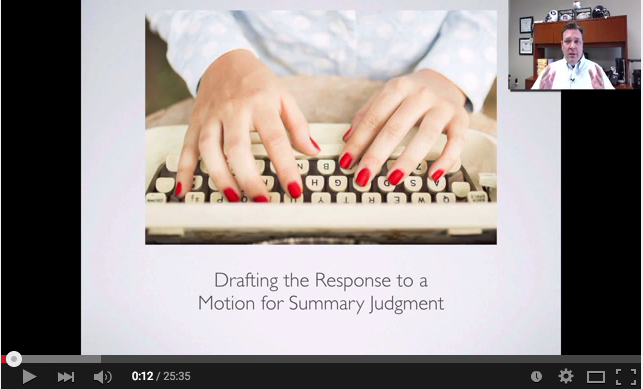** Update ** Check out the link at the bottom of the page to my new course on How to Draft your own Response to a Motion for Summary Judgment.
***********************************************************************************
Nothing can blow your case out of the water like a motion for summary judgment. You got served with a debt collection lawsuit, you searched the Internet and were able to piece together an Answer to avoid a default judgment, and may even have muddled through the discovery process and your case is still alive and well. You still have a glimmer of hope that you may actually get out of this case alive, and then it happens. You get hit with a motion for summary judgment.
Drafting an adequate response to a motion for summary judgment separates the true Consumer Warriors from the rank amateurs. Your day in court has arrived -albeit sooner than you thought. If you don’t put together a good response – or worse yet if you don’t respond at all – you may find your case coming to a screeching halt and a judgment entered against you. Here are 3 vital steps to defeating the debt buyers‘ motion for summary judgment:
#1 – Get out Your Calendar
This one should sound familiar. Remember when you first got served with the complaint and summons? I told you the first thing you need to do is pull out your calendar and mark when the Answer was due. Same thing with responding to a motion for summary judgment. You need to make sure and mark on your calendar the deadline when it is due. Just like with complaint, if you don’t respond the court will assume you agree with everything that has been alleged and grant judgment against you.
So how long do you have submit a response? Check your local rules of civil procedure, but if your state modeled their rules after the federal rules (and most states have) you can look in Rule 56 and it will tell you. Under federal law (and many states) it is 30 days. Check your local rules to be sure.
#2 – See the Big Picture
An important part of responding to a motion for summary judgment is understanding exactly what the document is. A motion for summary judgment is the debt buyer’s way of saying “look judge, the facts of this case are not in dispute. The only thing we need you to do is look at the facts and give us a legal ruling as to who wins”. Basically, the motion for summary judgment is a way to shorten the litigation process. Instead of a trial, the debt buyer is trying to win the case by filing a written motion.
#3 – Drafting Your Response
Now for the hard part. What do you actually write in your response? The key to defeating a motion for summary judgment is to show the court that there are still facts in dispute. Summary judgment is only appropriate if none of the facts are disputed. However, if there are facts that are disputed the case should be heard at a trial where each side can present their version of the facts and have the chance to cross-examine each other before the judge makes a decision.
In the debt buyer lawsuits filed by companies like Midland Funding, LVNV, LLC, or Portfolio Recovery there are many facts that are in dispute. Here are a few:
Standing: The central fact in dispute in a debt buyer collection lawsuit is if the plaintiff actually owns the debt that they are suing on. Typically the debt buyer has very little admissible evidence to show that they actually purchased the debt from the original creditor. Without admissible evidence showing that they purchased the debt, they don’t have standing to sue on it. Sure, they may have provided documents like affidavits and a few statements, but if you read these documents, they don’t provide any real evidence that they purchased the debt.
Generally the affidavits are written by someone who works for Midland Funding or one of the other debt buyers. In these affidavits they swear that they purchased the debt. But what else would we expect them to say? Of course they are going to say that! But where is their evidence? Where is the bill of sale WITH exhibits showing that your specific account was purchased? They normally don’t have these documents.
So, the big fat fact that is at issue is if the plaintiff even has the right to sue you. You must present this in your written response to the motion for summary judgment.
Dollar Amount Owed: Even if the debt buyer could prove that they own the debt (and I have yet to see one that could), how did they calculate the amount owed? Did they just throw a two-year old credit card statement before the court and claim that was the amount owed? How did they calculate the amount they are seeking? What interest rate did they use? Did they properly account for any payments that were made on the account? They must show this. If they can’t there is a factual dispute on how they came up with the number that should be dealt with in a trial, not a summary judgment motion.
Step-by-Step Course
Facts Specific to Your Case: Finally, you need to bring up any facts specific to your case that may be in dispute. On more than one occasion I have represented clients against debt buyers where my client had paid the underlying debt in full and had proof (canceled checks type proof) that the debt had been paid. If you have paid the underlying debt or if you didn’t incur the underlying debt (i.e. identity theft) then you need to make sure and raise those issues as well. They are factual disputes that should stop the judge from granting the debt buyers’ motion for summary judgment.
One final note, after you draft your motion, make sure you file it with the court and send a copy to the debt buyers’ lawyer. The court usually doesn’t do this for you and if you don’t send them a copy they will never know you filed it. Again, draft a response that demonstrates there are still facts in dispute in your case and file it before the deadline with the court. If you can clearly demonstrate that there are factual issues that need to be resolved by the court, you should be successful in your battle against the debt buyers.
New Self-Help Course on How to Draft a Response to a Motion for Summary Judgment
**Update**
I originally drafted this article in 2014 and since then tens of thousands of people have read it with hundreds more reading each day. I know many people aren’t sure how to respond to a motion for summary judgment and can’t afford an attorney. In hopes of bridging this gap I decided to put together a self-help online video course to help people draft their own Response to a Motion for Summary Judgment.
This course is now LIVE! Check it out by clicking HERE:
Sign Up for a Free Consultation
We can do this...Let's Solve Your Debt Problem!


